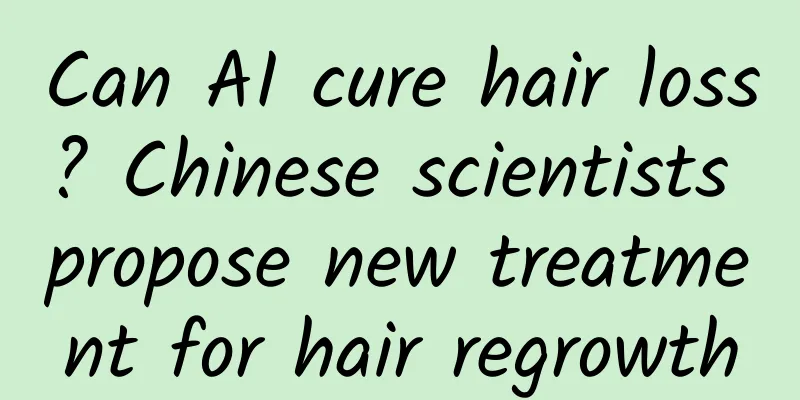Can AI cure hair loss? Chinese scientists propose new treatment for hair regrowth

|
Nowadays, hair loss has become a headache for contemporary young people. Due to the fast pace of daily work and life, high pressure, and irregular work and rest habits, hair loss, baldness, and high hairline have gradually become younger. Regardless of age, hair loss is a very distressing thing for anyone, as a person's hairstyle is often related to their level of self-confidence. Faced with the embarrassing situation of "sudden baldness", some people choose to accept the reality of baldness, while others hope to regain a full head of black hair. Nowadays, artificial intelligence (AI) technology may become a good helper for people to get rid of the trouble of hair loss. Recently, with the help of AI, the team of Associate Professor Wang Lina from the School of Environmental and Safety Engineering of Qingdao University of Science and Technology, the team of Associate Professor Zhu Zhiling from the School of Materials Science and Engineering and their collaborators designed a nanozyme with better performance and constructed a proof-of-concept microneedle patch, which effectively achieved hair regeneration in mice . The related research paper, titled "Machine Learning Guided Discovery of Superoxide Dismutase Nanozymes for Androgenetic Alopecia", has been published in the scientific journal Nano Letters. Currently, most people with severe hair loss suffer from androgenetic alopecia, a type of hair loss that affects both men and women and is caused by genetic factors and the effects of androgens. Testosterone is a common and important androgen, secreted by the male testicles or female ovaries, and a small amount by the adrenal glands. Once it reaches the hair follicles, it is converted into dihydrotestosterone (DHT), another androgen that is considered a major culprit of hair loss. It can cause hair follicles to shrink and hair to become thinner. For women, although estrogen in the body can inhibit androgen, if the hormone balance in the body is broken or estrogen decreases after middle age, hair loss will occur due to excessive androgen. In this case, the paper describes, hair follicles become damaged by androgens, inflammation, or excess reactive oxygen species, such as oxygen free radicals. When levels of oxygen free radicals are too high, they overwhelm the body's antioxidant enzymes that normally keep them in check. Superoxide dismutase (SOD) is one of the antioxidant enzymes. Scientists have also created an analog based on this enzyme, namely nanozymes, but they do not perform well in removing oxygen free radicals. Therefore, the research team tried to explore whether artificial intelligence could help them design a nanozyme that could better treat hair loss. In this work, they selected transition metal thiophosphites as potential nanozyme candidates and tested the machine learning model using 91 different combinations of transition metals, phosphates, and sulfates. Figure | AI guided the discovery of SOD-like nanozymes. (Source: This paper) The prediction results showed that MnPS3 would have the most powerful SOD-like ability. They then synthesized MnPS3 nanosheets through chemical vapor transport of manganese, red phosphorus and sulfur powder. In preliminary tests on human skin fibroblasts, the nanosheets significantly reduced the levels of reactive oxygen species without causing harm. Figure|MnPS3-like SOD activity. (Source: This paper) Based on these results, they created MnPS3 microneedle patches and used them to treat a mouse model affected by androgenic alopecia. Within 13 days, the mice regenerated thicker hair compared to mice treated with testosterone or minoxidil. The researchers say their study both suggests a new nanozyme therapy for hair regeneration and demonstrates the potential of computer-based approaches in designing future nanozyme therapies. In addition, previous studies have confirmed that scientists can use genetic engineering to reprogram cells, converting ordinary cells (such as blood or fat cells) directly into hair stem cells to treat hair loss. Although science and technology can help people grow "lost" hair again, perhaps the simplest and most effective treatment is internal self-regulation, actively adjusting your mindset, ensuring adequate sleep, eating a balanced diet, quitting smoking, combing your hair frequently, etc. Finally, I hope everyone can stay away from hair loss, baldness and a higher hairline. Reference Links: https://pubs.acs.org/doi/full/10.1021/acs.nanolett.2c03119 https://ha.qust.edu.cn/info/1013/1513.htm https://cl.qust.edu.cn/info/1246/3534.htm |
<<: How come cockroaches, which have been "extinct" for more than 80 years, reappeared? !
>>: Was our moon "spitted out" by the earth?
Recommend
If the blood type does not match the parents', does that mean the child is not their biological child? The answer may not be exactly what you think →
After donating blood, a female college student di...
"Prince Diary" - School is back! What was written on the "leave note" over 3,000 years ago?
At the beginning of September, the autumn breeze ...
【Game Promotion】See how the major game manufacturers do it! Marketing promotion strategy
Let’s take a look back at the last month of 2014....
A brief analysis of the commercial monetization strategy of automotive apps
The editor has received a small request for inter...
Do you know the correct way to resist cold waves?
The Tianlan Youfang column is a knowledge sharing...
“Health from Food” Series | What will happen to your body if you drink coffee for a long time?
Coffee is one of the three major beverages in the...
The product is too boring? 7 tips to help you create interesting marketing content!
If you were to ask: Which brands do you think hav...
3G or 4G? Are you also switching from “3” to “4”?
4G has been around for some time. Since the Minis...
What is SEM Marketing? What are the advantages of SEM?
Everyone knows that there are many ways of online...
The data and effects of major mobile game launches are all here!
Mobile game traffic has three main sources: chann...
Both are made of carbon, so why is graphite soft and diamond hard?
Produced by: Science Popularization China Author:...
Alipay is in big trouble! Huabei and Jiebei will be disconnected, and Yu'ebao will also be affected
[[396720]] Since Ant Group's IPO was suspende...
VisionMobile: IoT Developer Program Best Practices Survey (Infographic)
199IT original compilation Developers value the c...
How much does it cost to join the Baishan Fast Food Mini Program? What is the price for joining Baishan Fast Food Mini Program?
Is it easy to join the Baishan fast food mini pro...
A brief discussion on iOS version numbers: Developers on how to better use version numbers to identify applications
We have been trying to make version numbers compa...









